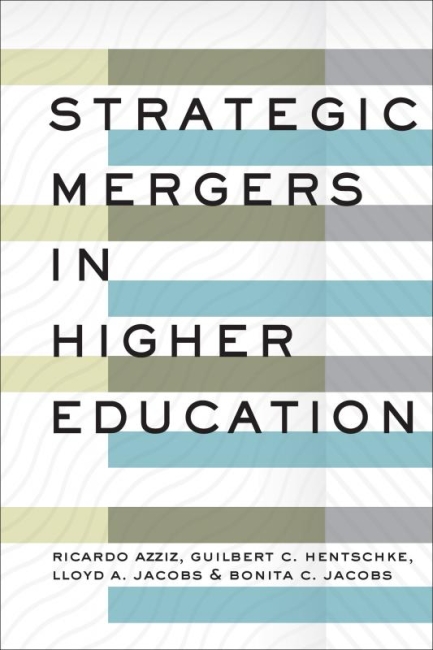You have /5 articles left.
Sign up for a free account or log in.

Courtesy of Johns Hopkins University Press
Mergers between colleges and universities should not be viewed only as last resorts.
So says a new book published today, Strategic Mergers in Higher Education (Johns Hopkins University Press). Instead, merging should be “a tactic to be considered proactively, deliberately, and without fear,” it says.
But fear tends to creep in when knowledge is lacking. And the book’s authors found little existing practical guidance on the process of merging two institutions.
They seek to add to the available resources by drawing on an analysis of over 100 mergers in the United States since 2000, interviews with more than 30 leaders involved in higher ed mergers and their own considerable experience.
The book’s authors are Ricardo Azziz, who led a merger creating what is now Augusta University, in Georgia, and who is now a research professor at the University at Albany in the State University of New York system; Guilbert C. Hentschke, who served as dean at the University of Southern California’s Rossier School of Education from 1988 to 2000 and is chair emeritus there; Lloyd A. Jacobs, who led a merger between the University of Toledo and the Medical College of Ohio and who is president emeritus of the university; and Bonita C. Jacobs, who led the merger that formed the University of North Georgia and who still serves as founding president at that institution.
The new book is a “practical go-to guide for higher education campus managers and executives, their boards, and related decision and policy makers,” its authors wrote. It could also be useful for leaders who have to execute a merger and for anyone interested in the future of higher education or change management.
It might be publishing just in time for some campuses. Shifts in the higher education landscape have led to increased interest in mergers among college and university leaders in recent years, and many have moved forward with merger plans. Just last week, Henderson State University’s Board of Trustees voted to merge with the Arkansas State University system. Only a few weeks earlier, Roosevelt University in Chicago announced plans to acquire its neighbor Robert Morris University.
The new book’s authors collectively answered questions via email. The following exchange has been edited lightly for length and clarity.
Q: What barriers do you see to mergers, either across higher education as a sector or repeatedly rising within individual institutions?
A: As we noted in our book, the most pervasive barrier we have observed is the failure of consideration, i.e., the failure of governing boards and executive leaders in higher education to even consider a merger as a proactive option in their strategic planning. Much of this oversight arises from the unfounded belief that a merger signifies failure, even though mergers are a well-tested approach to rapidly securing growth, stability and value. And many boards and leaders forget that mergers are a two-way street. While some institutions undoubtedly seek a merger when all else has been exhausted -- in extremis, if you would -- for many more institutions, a merger should be and is a significant growth opportunity. An opportunity that many boards and leaders overlook.
A second barrier is the failure of most boards and executive leaders to undertake careful strategic planning with an eye to long-term (decades) sustainability and growth. Many institutional leaders focus solely on this fiscal year, or perhaps the next, an understandable stance considering the role of many of these leaders as the indefatigable cheerleaders of their institutions.
A third barrier is the belief of many leaders and governing boards that all change in higher education should be incremental and start from the ground up. Unfortunately, transformative change is, by definition, not incremental, and transformative change, with the exception of populous revolts, is rarely driven from the ground up.
A fourth barrier is the fact that most institutions that would benefit from a merger for sustainability and stability unfortunately wait too long. When colleges wait too long, their financial, political and enrollment value declines to the point that they may be unable to find a willing partner. A recent analysis by Robert Witt and Kevin P. Coyne also supports this assertion. In their analysis of mergers since 2016, they found that few if any failing private colleges should expect to find a willing merger partner.
Q: Is there a particular set of institutions that are likely to be good merger candidates?
A: Broadly speaking there are two groups of institutions that should consider mergers. The first are future-oriented institutions that are looking to add value and competitiveness in a significant way for their students and communities through growth and expansion -- growth and expansion of academic programs, geography and reach, physical plant, enrollment, student and faculty diversity, scholarship and research, and the like.
The second are future-oriented institutions that have begun to understand that their future is difficult and not promising, which places their students, faculty and programs at great risk. These institutions want to seek merger partners to enhance the long-term competitiveness, stability and sustainability of their programs, even if that would mean ceasing to operate as an independent entity.
There is a third group, although these are essentially those institutions in the second group above that have waited too long -- and which often fail to find a satisfactory merger partner. As mentioned above, although these tend to be more common today, it is our hope that with better, more comprehensive strategic planning, a more proactive approach to the future and a more complete consideration of all strategic options, options including mergers can be implemented.
We should note that systems of higher education, whether public or private, generally include and oversee colleges and universities that have similar cultures if not missions, and consequently good merger partners are more likely to be identified within individual systems.
Q: Some leaders see mergers only as transactions involving land and physical assets like buildings. Are mergers viable options for colleges that don’t have valuable land -- those isolated in rural areas with low property values, for example?
A: When an institution has exhausted its value (see above), then often all that remains is their capital facilities and land -- assuming there are no liens or debt on these! However, this view of mergers speaks to what we are advocating against.
Institutions whose primary goal is to seek greater future stability and sustainability should strive to be of as much value to a merger partner [as possible]. They should definitely not wait too long; e.g., they likely should have at least five, if not 10, years of guaranteed existence ahead.
Alternatively, institutions that are looking to grow should consider acquiring institutions that are more than land transactions, seeking to potentially acquire new students, programs, geographic reaches, etc. Higher ed institutions have a myriad of approaches to acquiring land and facilities, and a merger solely as a land transaction is no merger at all. Nonetheless, such a transaction may be a viable option, depending almost entirely on how those physical assets (land, buildings, etc.) advance the strategic mission of the acquiring institution.
Q: How do you suggest finding a good merger partner?
A: Many merger partners are discovered spontaneously, either due to personal relations between leaders or mere geographic proximity.
However, as we detail in our book, we believe a better approach for many mergers may be to approach identifying a merger partner systematically, much as one should approach any other major business decision. We speak to proactively deciding what type of merger an institution would benefit most from, exploring strategic and cultural fit, horizontal and vertical integration, and regional reach. However, we do understand that because many merger partners are sought locally, geographic proximity often plays an inordinately important role in deciding on a merger partner.
The search should be conducted quietly and confidentially and should preferably begin with an in-person conversation, rather than sending out a blank request for proposals to the universe of potential partners an institution has defined.
This “search to find” process should only be conducted within the broader context of a coherent strategic plan accepted by key institutional decision makers.
Q: What role should shared governance and the faculty play?
A: Faculty should play a critical role in considering and implementing a merger. Their role in the implementation of the merger process is fairly clear, as faculty and faculty leaders should be involved in all parts of the integration process. However, when engaging faculty in the process of consideration of a merger, there are two issues that need to be taken into account.
Firstly, the process of consideration, searching for partners, negotiation and decision making for mergers often, if not always, requires careful attention to confidentiality and privacy. Engaging faculty representatives during this period of time, then, requires that these representatives understand their duty to maintain strict confidentiality, if requested, while accurately providing the faculty viewpoint.
Secondly, as noted above, engaging the faculty must be done through designated representatives. Unfortunately, very often individual faculty members do not feel that their voices are adequately represented by their elected representatives and hence demand that each be heard individually. This, of course, is simply impossible to achieve. Thus, it is critical that elected faculty representatives have the proper degree of delegated authority, leadership and gravitas if they are to be engaged in the consideration process of a merger.
Q: Can boards help mergers by introducing business concepts to the higher ed space?
A: Yes. Governing boards should embrace their generative and strategic roles and support and encourage their chosen leaders to pursue a future-oriented envisioning while discouraging institutions from pursuing the too-frequent race to mediocrity. While introducing business concepts might help, focusing on better leadership development, including the acquisition of business tools and a better understanding of change management, might be a more comprehensive approach.
Q: What concerns other than finances -- like impact on underrepresented students or program availability in a state -- should be considered in a merger process?
A: Students should be the first and primary concern of any institution of higher education, whether merging or not. As such, the impact and value of a merger on students should always be assessed, not only for current students but also those of the future and past. However, often mergers, while painful to many faculty and administrators, are ultimately a positive experience for students. Some mergers may be associated with changes in admission or graduation requirements, and in these it will be critical to ensure that subgroups of students are not negatively impacted, and if so, have a plan in place to address.
Other concerns when considering mergers include cultural and strategic fit, the driving vision for the merger and the degree of urgency established. Other important concerns include ensuring a robust communication strategy and an experienced project management system.
Q: What can we learn about mergers by comparing other parts of the world to the United States?
A: In our book we explore mergers across the world. The consideration and partnering processes in many parts of the world are more centrally driven than many mergers in the United States, with the exception of mergers of public institutions. However, the actual process of integration -- amalgamation of the various administrative and support entities and the long-term journey to developing a new and broader campus culture -- are similar between the many mergers across the world and those in the United States. International mergers provide important lessons for institutions of higher education in the United States.
Q: What else should leaders know?
A: Mergers are simply one more tactical arrow in a strategic quiver. Considering a merger does not commit leaders to merging but does broaden the options available. And considering a merger encourages leaders to critically examine their institutions’ future and long-term future prospects.
Mergers require leaders with vision and courage and governing boards who are willing to provide cover and support.




